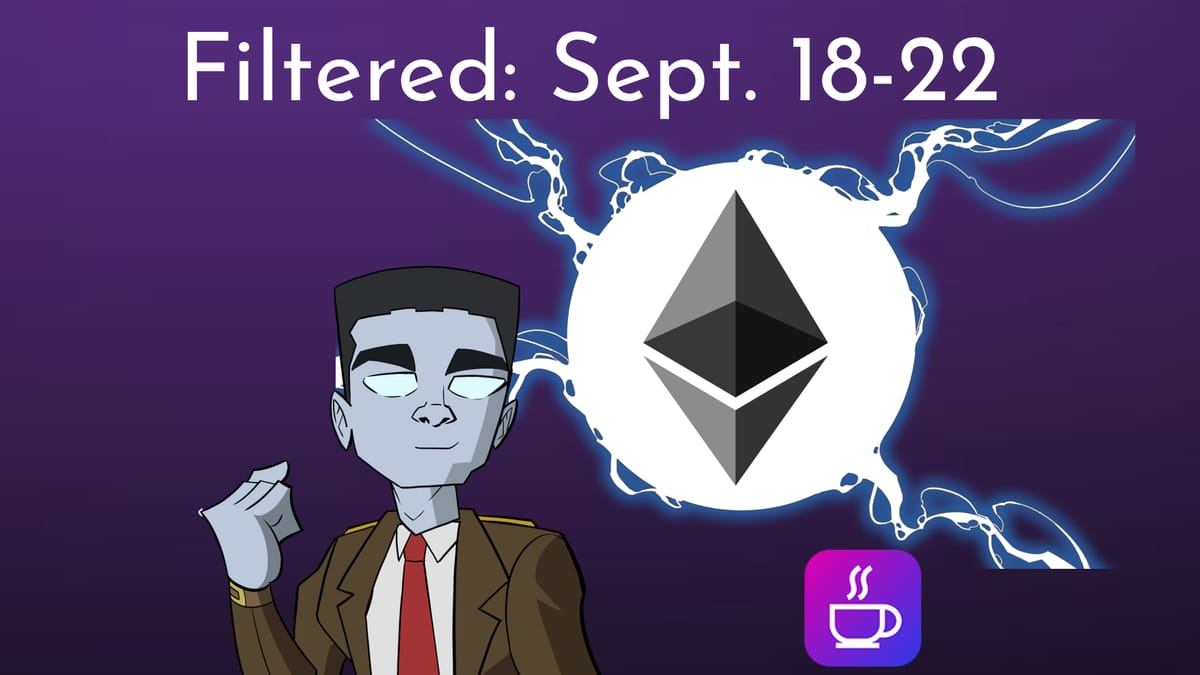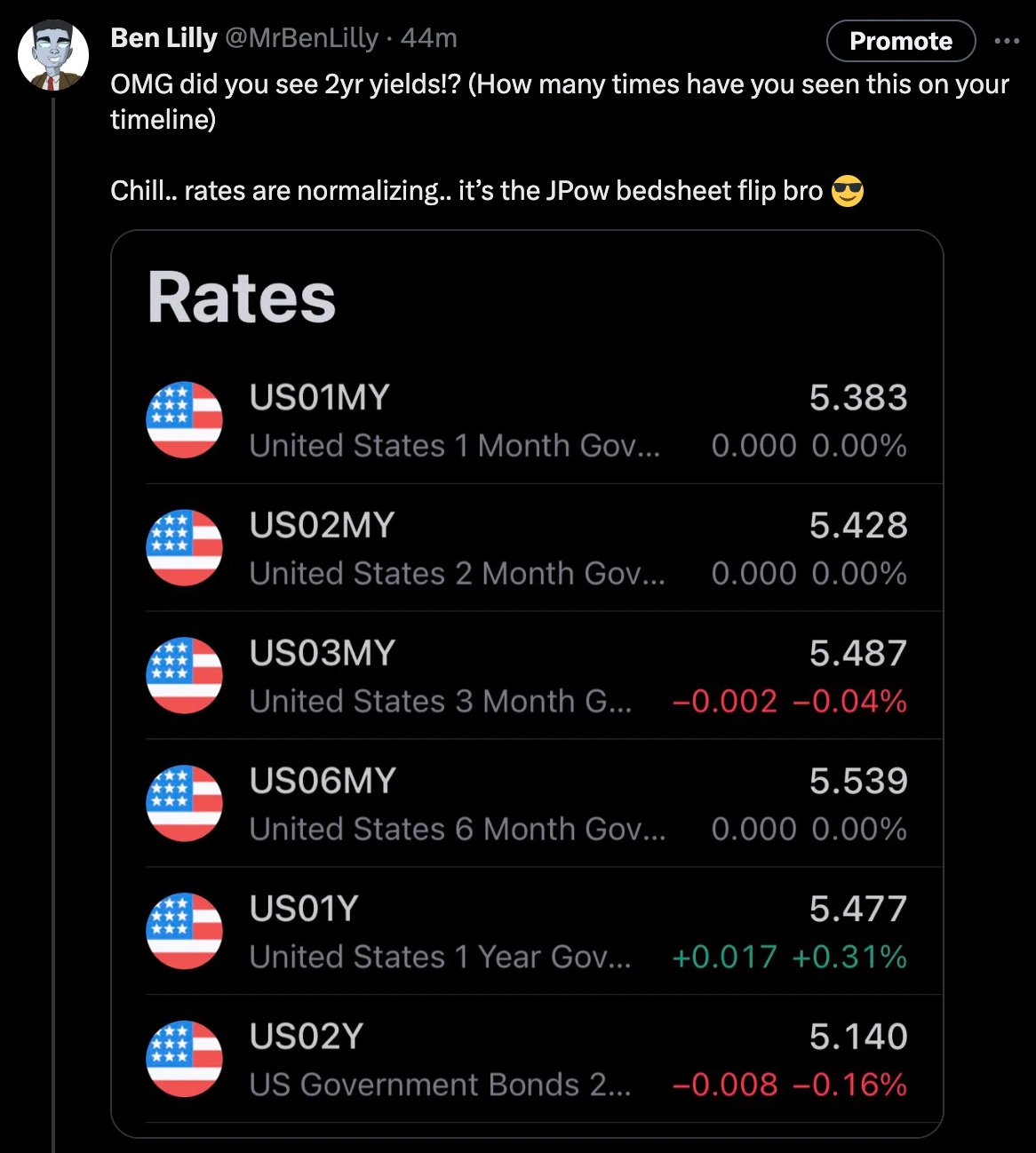What These Projects Can Learn From Ethereum
Filtered: September 18 – 22

Crypto’s taken some hard hits over the past year. But if you look beyond price and dig deeper into fundamentals, one project’s looking better than ever.
Twelve months after the Merge, Ethereum (ETH) is living up to its promise.
According to ultrasound.money, since Ethereum officially switched to a proof-of-stake network, it’s reduced its supply by a net amount of over 295,000 ETH, or by an annualized 0.24%.
Yes, its price of $1,580 is still roughly the same as when the Merge happened. But now, by leaving behind the proof-of-work mechanism (which would’ve increased supply by over 3% in the same time span), the protocol has succeeded in becoming deflationary.
That said, supply is only part of the story. We also have to look at demand...and how the token is used.
Users can deploy ETH to create a smart contract, pay gas fees, deposit it as collateral, stake it, what-have-you. The token has plenty of use cases to stimulate demand.
And several other projects would do well to take a lesson from ETH’s versatility, as our audience learned this week.
On Monday, I tackled a token that had a hot start to the year with its much-anticipated airdrop, before falling on hard times.
While Arbitrum has managed to stay competitive with other layer-2 networks like Optimism, it hasn’t really unlocked the value of its ARB token yet. And that will be crucial if the network wants to survive long-term, as I wrote in Espresso:
The token needs to have some level of usage, even if it’s basic. And once it has that, it can start to unlock higher levels of usage similar to what we see with ETH.
The benefit of this is that it makes TVL [total value locked] very sticky. All that liquidity can then act as a sinkhole which better absorbs changes in supply.
Right now, ARB doesn't have that. If there was a big unlock coming or one of the protocols on the network wanted to sell the tokens it acquired from the airdrop, the ecosystem wouldn’t be able to absorb it.
Bottom line is I would like to see greater usage of the ARB token outside of just being sold into the market. Right now, if I had to give ARB’s economics a grade, it would receive an F.
I shared one idea for how Arbitrum could find greater usage for its token, which you can read in full right here.
But Arbitrum’s not the only one struggling with designing its token.
In the latest Alpha Bites episode, the XChanging Good team focused on Cosmos as part of our new “Beta Plays” segment. While Kodama broke down how Cosmos’ tech stack works, and J.J. looked at its technicals on the charts, yours truly analyzed how it could do better with its ATOM token.
Specifically, why it needs to offer users more options with it than just staking:
The token supply growth rate...is sitting at 17% per year, which explains a lot of the behavior of staking users.
They're just simply trying to preserve their purchasing power on the network, and that's why they're staking to get a percentage of all that new token supply. And so protocols need to offer massive rewards to encourage higher order usage of the token.
...
So with a staking reward that high, how can credit markets actually grow? How can they attract liquidity? How are you going to get diversity on the various protocols that sit on your network?
So that's inhibiting growth right off the bat. You clearly need people to move their ATOM out of staking into something else.
...
You look at where ETH sits in the ecosystem. And it's essentially all over the place. You got it on MakerDAO. You got it on Compound and Aave. You have it sitting over in Lido and Rocket Pool. You have it in various different buckets, and you don't have it just sitting on the Beacon Chain.
I think that figure’s around 20% right now. And so ETH, in terms of where it sits and how it's being used, is very diverse. And we don't see that happening in the Cosmos ecosystem.
You can check out the team’s full breakdown of Cosmos by listening to the episode here.
But it wasn’t the only project we analyzed this week. Our own token design guru Kodama gave us a snapshot of three projects on his “Like It or Spike It” segment, including a big Web3 move from an app you all have probably used before.
A self-custodial wallet called TON Space has launched on Telegram, using a blockchain that the app once owned before turning it over to a group of open-source developers. And Kodi has an idea on why it might point to the future of blockchain apps:
It's a different chain compared to Ethereum and whatnot. It has only like $10 million in TVL. But where I think it...can find a lot of success is in getting a lot of users to use blockchain, even if it's not immediate to them that they're actually using a chain.
And so [Telegram] has just launched a Web3 wallet. You can do a bunch of things. You can hold your tokens in there. You can send them. I think the transfers are cost-free. You can trade NFTs, yada, yada. And Telegram already has so many users and it becomes trivial for them to now have a Web3 wallet.
So I think instead of chains, financial projects [should] go social. Maybe it's the social apps that go Web3 and that's how you get success. And Facebook was trying this before it got shut down. So if [the app] doesn't get shut down, I think that this could be huge.
Meanwhile, Bitcoin (BTC) mining stocks have started to cool off after an incredible year of triple-digit gains. And all the talk of a potential spot Bitcoin ETF getting approved has the market wondering how that might affect mining companies.
Independent analyst Ray has been following this space pretty closely, and this week he chimed in with his thoughts:
So I've got a dual-pronged theory on what might happen here and how it impacts mining stocks. It's simple.
Either A: An ETF is approved, and this sideline money flows into spot Bitcoin and the ETF, effectively sucking volume out of the Bitcoin mining stocks and into BTC. And we continue to see...the risk sentiment and euphoria around investing in those stocks wither.
Or B: A rising tide lifts all boats, to the extent that the rush of inflow into the spot Bitcoin ETF also boosts Bitcoin’s price and the valuation of public miners as companies, which should improve their ability to further raise funds and build out their operations or participate in any mergers and acquisitions that might be happening after the halving.
Ideally, these actions would reflect positively on Bitcoin mining stocks as well.
Another alternative is no ETF approval. [The can] just keeps getting kicked down somehow. And if that's the case, then we're dependent upon macro and spot Bitcoin price action as gauges of investor risk sentiment. And we see how that impacts Bitcoin mining stocks.
Beyond averaging into the strongest companies, it seems like the wiser move might be to wait and watch. Keep an eye on the charts. Keep an eye on the metrics that reflect whether or not a company is healthy and how Bitcoin itself performs leading into the halving.
And for a brief look at how Bitcoin is performing right now, we turned to the man with the mop himself to give us an update:
This is one of the most confusing market setups I've seen. What makes me want to pay attention to it even more is how back-and-forth the market's been in this range, right?
Like we're at the top end of the range, and then we're at the bottom end of the range. But it's just essentially been a really wide range for over half a year now since the fallout of the banking crisis in March.
We've just seen Bitcoin between $25,000, and that's all it's been, so it does seem like we're gonna get that decisiveness, right? And whether that is Bitcoin breaking back above its 200-day moving average, possibly moving back above $30,000 into the end of the month. That could be a very bullish setup.
We obviously know what's ahead into the end of the year, with things like the ETF decisions and whatnot. So it's definitely time to keep an eye on it. I know we've been saying that for a while, but this market is soaking up as much liquidity as it can in this range. And I do think that time's ending.
So I do think within the next few weeks, we'll send above $30,000 or down below $24,000, but we should have our moment of decision coming up here pretty soon.
Once again, you can listen to the entire Alpha Bites episode on YouTube here, or on Apple Podcasts or Spotify.
Finally, this week we announced a shift in our promise to you going forward. While we’ve always tried to maintain a healthy balance of macro and crypto content, it’s clear that the latter is more of what you, our audience, desires from us. So that’s what we’ll be focusing on more in the months to come.
In preparation for that move, on Wednesday, I shared my overall macro outlook for the next few years so that we can zero in on what it means for crypto. Here’s a snippet:
It’s as if every traditional institution discovered what Tether is doing… They take in dollars, issue a token on the public blockchain that’s redeemable for dollars, buy Treasuries with the dollars you deposited, and hold the yield from those Treasuries for themselves.
The result: over $2 billion in revenue for the first two quarters of 2023 on approximately $80 billion of assets. It’s essentially a 5% annual yield on managing a payment infrastructure.
Now, for anybody who was listening in on last week’s Digital Dollar hearing in Washington, you know that banks are taking note. But they have a bit of an issue.
If a customer places a dollar in the bank’s vault, and the bank issues a tokenized form of that debt, the bank can’t lend out that dollar to somebody else. That’s because their customer still technically holds the asset by owning the token.
The banking lobbyist is scared that this would create tighter credit conditions… especially as regulations are about to shift to require banks to hold more capital (Basel III endgame).
But their worries are a symptom of their nearsightedness.
Banks typically only make about 1% on their assets, and that accounts for about 65% of their revenue.
Right away, we can see Tether’s model is much more productive.
The full piece examines this more in depth and how it could impact crypto. Be sure to give it a read.
As always, you can find links to all the content we published this week below – along with our Tweet of the Week.
That’s all from me this week. Enjoy the weekend.
Your Pulse on Crypto,
Ben Lilly
Espresso:
- How Arbitrum Can Turn Its Token Around
- Changing Our Approach
Alpha Bites:

Tweet of the Week:
Remember JPow discussing how to lay bed sheets? No?!
Well here he is at the podium explaining to Espresso readers in January his Martha Stewart-approved tactic for normalizing the yield curve..

And here’s the tweet…






